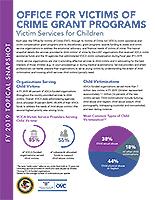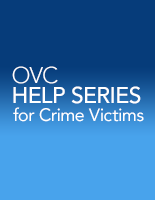Child (under 12)
Promising Practices: Multidisciplinary Responses to Complex Homicide Cases
Office for Victims of Crime Grant Programs: Victim Services for Children FY 2019 Topical Snapshot
Funding Opportunity: FY 2021 Coordinated Tribal Assistance Solicitation
November 2020 Featured Resources
National Native American Heritage Month
Every November, we commemorate National Native American Heritage Month. In his proclamation, President Trump states “This month, as we recommit to supporting Native American Tribes and people, we resolve to work side-by-side with their leaders to secure stronger, safer communities and preserve their sacred heritage for future generations.”
The Department of Justice has a long-standing commitment to improving public...
Repaying Debts
Director Hart Visits Austin, Texas to Hear from Providers About Serving Victims During the Pandemic
Office for Victims of Crime Director Jessica E. Hart visited Austin, Texas on Wednesday, October 14, 2020, to hear from the field and announce grant awards to national and state programs.
Director Hart began her day with a tour of the National Domestic Violence Hotline. The Hotline, funded in part by the Office for Victims of Crime, operates 24 hours a day, 365 days...
Office of Juvenile Justice and Delinquency Prevention: Supporting Youth and Families Impacted by Opioid Abuse
Office of Community Oriented Policing Services: Drug Endangered Children Training Series
The Beat: Wrongful Convictions
OVC Help Series for Crime Victims: What Adults Need To Know About Child Abuse
Children Exposed to Violence: Criminal Justice Resources
Internet Crimes Against Children
Community Outreach Through Police in Schools
Children at Clandestine Methamphetamine Labs: Helping Meth's Youngest Victims
Breaking the Cycle of Violence: Recommendations to Improve the Criminal Justice System Response to Child Victims and Witnesses
School Crisis Response Initiative
Coping With the Holidays After the Death of a Loved One or When You Are a Victim/Crime Survivor
OVC Help Series for Crime Victims: Sexual Violence
OVC Help Series for Crime Victims: Child Abuse
OVC Help Series for Crime Victims
Through Our Eyes: The Child Advocacy Center Model
This video discusses the Child Advocacy Center Model, which brings together representatives from many disciplines, including law enforcement, child protection, prosecution, mental health, medical and victim advocacy, and child advocacy, to provide comprehensive services to child victims of abuse, neglect, and trauma. Child Advocacy Center multidisciplinary teams also work collaboratively to make decisions about the investigation, treatment, management, and prosecution of child abuse cases; and to support children and their families through the criminal justice process.
See the YouTube Terms of Service and Google Privacy Policy
Remarks as Prepared for Delivery by OVC Director Jessica E. Hart During a Webinar Hosted by the Ohio Attorney General's Office
Good morning! Thank you, Attorney General Yost, and all the staff in your office who worked hard to make today's webinar happen. I sincerely appreciate the opportunity to introduce myself and share a bit about the Office for Victims of Crime.
As previously mentioned, I was appointed the Director of OVC, a component of the Office of Justice Programs at the Department of Justice, in...
Through Our Eyes: Introduction
See the YouTube Terms of Service and Google Privacy Policy
Funding Opportunity: OVC FY 2020 Improving Outcomes for Child and Youth Victims of Human Trafficking
Apply for the OVC FY 2020 Improving Outcomes for Child and Youth Victims of Human Trafficking solicitation.
OVC is seeking applications for states or Tribes to develop, enhance, and coordinate programs and activities geared toward improving outcomes for child and youth victims of sex and labor trafficking. The overall goal of the program is to improve responses for child and youth victims of trafficking with...



